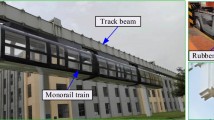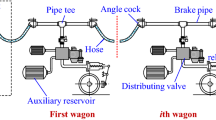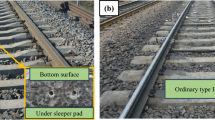Abstract
The friction coefficient resulting from the road surface condition directly affects the vehicle braking condition and distance. In the American Association of State Highway and Transportation Officials (AASHTO), the braking distance for different speeds, upgrades, and downgrades is recommended. However, the effects of the variations in the friction coefficient, type, and weight of vehicles are not directly taken into account. Therefore, the present study firstly examines the effects of the variations in vehicle speed, friction coefficient, longitudinal grade (upgrade and downgrade) in AASHTO 2018, and the vehicle type on braking distance. Secondly, a nonlinear analytical approach is considered to estimate braking distance and determine a critical friction coefficient that causes decreases in the braking distance. The findings indicate that under dry road surface conditions (with a friction coefficient of 0.6), the weight of the vehicle predominantly influences braking distance, resulting in heavier vehicles having shorter braking distances than lighter vehicles across all selected grades, except at a − 6%. However, when the road surface friction coefficient decreases from 0.6 to 0.18, the impact of vehicle weight surpasses the effect of the longitudinal grade, leading to an increase in braking distance. Consequently, when designing a road, it's essential to consider not only the technical road parameters and vehicle dimensions but also the vehicle weight and the road surface conditions in areas prone to snowfall, among other factors. If we wish to account for snowy and icy conditions, in addition to AASHTO's classification of wet conditions, in order to refine predictions of braking distance, the results of this study can provide valuable insights for road designers.
















Similar content being viewed by others
References
Zhao Y Q, Li H Q, Lin F, Wang J and Ji X W 2017 Estimation of road friction coefficient in different road conditions based on vehicle braking dynamics. Chin. J. Mech. Eng. 30(4): 982–990
Pal S and Roy S K 2019 Impact of side friction on performance of rural highways in India. J. Infrastruct. Syst. 25(2): 04019006
Šarkan B, Jaśkiewicz M and Kiktová M 2020 The impact of the truck loads on the braking efficiency assessment. Open Eng. 10(1): 105–112
Günay M, Korkmaz M E and Özmen R 2020 An investigation on braking systems used in railway vehicles. Eng. Sci. Technol. Int. J. 23(2): 421–431
Greibe P 2008 Determination of braking distance and driver behaviour based on braking trials. In: 87th Transportation Research Board Annual Meeting, Washington DC, USA
Izeppi E D L, Flintsch G W and McGhee K K 2010 Field Performance of High Friction Surfaces (No. FHWA/VTRC 10-CR6)
Sabri M and Fauza A 2018 Analysis of vehicle braking behaviour and distance stop**. IOP Conf. Ser. Mater. Sci. Eng. 309(1): 012020
Himes S, Porter R J, Hamilton I and Donnell E 2019 Safety evaluation of geometric design criteria: horizontal curve radius and side friction demand on rural, two-lane highways. Transp. Res. Rec. 2673(3): 516–525
Rezaei D, Aghayan I and Hadadi F 2021 Studying perturbations and wave propagations by lane closures on traffic characteristics based on a dynamic approach. Phys. A Stat. Mech. Appl. 566: 125654
Aghayan I, Noii N and Kunt M M 2012 Extended traffic crash modelling through precision and response time using fuzzy clustering algorithms compared with multi-layer perceptron. Promet Traffic Transp. 24(6): 455–467
Malin F, Norros I and Innamaa S 2019 Accident risk of road and weather conditions on different road types. Accid. Anal. Prevent. 122: 181–188
Pacejka H B 2002 Tire and vehicle dynamics. Society of Automotive Engineers Inc, Warrendale, USA
Kim S, Kim J, Kim K, Kwon S, Lee B and Kang Y 2013 Parametric study using a braking distance simulation of an anti-locked braking system vehicle. Asian J. Chem. 25(9): 5263
Wang B, Guan H, Lu P and Zhang A 2014 Road surface condition identification approach based on road characteristic value. J. Terramech. 56: 103–117
Bartunek M, Moravčik O and Schreiber P 2012 Braking distance estimation by simulation. Appl. Mech. Mater. 128: 1131–1134
Fambro DB, Fitzpatrick K and Koppa RJ 1997 NCHRP Report 400: Determination of Stop** Sight Distances
AASHTO 2018 A Policy on Geometric Design of Highways and Streets. American Association of State Highway and Transportation Officials, Washington, D.C
AASHTO 1940 A Policy on Geometric Design of Highways and Streets. American Association of State Highway and Transportation Officials, Washington, D.C
AASHTO 2001 A Policy on Geometric Design of Highways and Streets. American Association of State Highway and Transportation Officials, Washington, D.C
AASHTO 2004 A Policy on Geometric Design of Highways and Streets. American Association of State Highway and Transportation Officials, Washington, D.C
AASHTO 2011 A Policy on Geometric Design of Highways and Streets. American Association of State Highway and Transportation Officials, Washington, D.C
Raad L, Lu J and Hulsey L 2002 Traction performance of transit and paratransit vehicles on ice and snow surfaces. In: Cold Regions Engineering: Cold Regions Impacts on Transportation and Infrastructure, pp. 290–298
Hall JW, Smith KL, Titus-Glover L, Wambold JC, Yager TJ and Rado Z 2009 Guide for pavement friction. NCHRP. Web-only document 108, Contractor's Final Report NCHRP Project 01-43. Transportation Research Board
Fwa T F, Pasindu H R and Ong G P 2012 Critical rut depth for pavement maintenance based on vehicle skidding and hydroplaning consideration. J. Transp. Eng. 138(4): 423–429
Oh Y and Lee H 2014 Characteristics of a tire friction and performances of a braking in a high speed driving. Adv. Mech. Eng. 6: 260428
Shoop S A and Kestler M A 2015 Updating side friction factors for design of unpaved roads. Transp. Res. Rec. 2472(1): 19–28
Qu G, He Y, Sun X and Tian J 2018 Modeling of lateral stability of tractor-semitrailer on combined alignments of freeway. Discrete Dyn. Nat. Soc
Li P and He J 2016 Geometric design safety estimation based on tire–road side friction. Transp. Res. Part C Emerg. Technol. 63: 114–125
Donnell E, Wood J, Himes S and Torbic D 2016 Use of side friction in horizontal curve design: a margin of safety assessment. Transp. Res. Rec. J. Transp. Res. Board 2588: 61–70
Meyers D R and Austin T P 2012 Dry pavement friction reductions due to sanding applications. SAE Int. J. Commer. Veh. 5(2012-01–0603): 239–250
Rajaei M, Sefidmazgi N R and Bahia H 2014 Establishment of relationship between pavement surface friction and mixture design properties (No. 14–4430)
Kordani A A, Rahmani O, Nasiri A A and Boroomandrad S M 2018 Effect of adverse weather conditions on vehicle braking distance of highways. Civ. Eng. J. 4(1): 46–57
Zamzamzadeh M, Saifizul A A, Ramli R and Soong M F 2018 Heavy vehicle multi-body dynamic simulations to estimate skidding distance. Baltic J. Road Bridge Eng. 13(1): 23–33
Sharizli A, Ramli R, Karim M R and Abdullah A S 2014 Simulation and analysis on the effect of gross vehicle weight on braking distance of heavy vehicle. Appl. Mech. Mater. 564: 77–82
Sharizli A, Ramli R, Karim M R and Saifizul A 2013 Novel method of determining braking distance of heavy vehicle using advanced simulation technique. In: Proceedings of the 3rd International Conference on Civil, Transport and Environment Engineering, 25–26 December, 2013. Bangkok, Thailand
Ibrahim A A and Abdullah M L 2013 The effects of vehicle speed and type of road surface on the longitudinal slip of tires and the brake stop** distance. Eng. Technol. J. 31: 1854–1869
Li S, Chen J and Huang H 2014 Investigation on emergency brake property of a heavy-duty vehicle based on functional virtual prototy** model. Open Mech. Eng. J. 8(1): 675–681
Kavitha C, Ashok B, Nanthagopal K, Desai R, Rastogi N and Shetty S 2017 Braking distance algorithm for autonomous cars using road surface recognition. IOP Conf. Ser. Mater. Sci. Eng. 263(6): 062034
Tong C and Li TZ 2015 Car driving safety analysis in rainy and snowy weather based on ADAMS/Car. In: CICTP 2015, pp. 2895–2903
World Road Association (WRA) 2003 Road Safety Manual: Recommendations from the World Road Association (PIARC). Route2 Market
MSC Software 2018 ADAMS manual. www.mscsoftware.com/product/adams
Dunn A and Hoover R 2004 Class 8 truck tractor braking performance improvement study. Low coefficient of friction performance and stability plus parking brake evaluations of four foundation brake configurations. In: Transportation Research Center Inc./National Highway Traffic Safety Administration
Abdollahzadeh Nasiri A S, Rahmani O, Abdi Kordani A, Karballaeezadeh N and Mosavi A 2020 Evaluation of safety in horizontal curves of roads using a multi-body dynamic simulation process. Int. J. Environ. Res. Public Health 17(16): 5975
Rahmani O, Tehrani H G and Nasiri A S A 2022 A new procedure for analysis of ride quality in roads using multi-body dynamic simulation. Innov. Infrastruct. Solut. 7(3): 209
Ferreira C 2006 Gene Expression Programming: Mathematical Modeling by an Artificial Intelligence 21. Springer, New York
Acknowledgment
None to declare.
Funding
None to declare.
Author information
Authors and Affiliations
Corresponding author
Ethics declarations
Conflict of interest
The authors declare that there is no conflict of interest in the paper.
Rights and permissions
Springer Nature or its licensor (e.g. a society or other partner) holds exclusive rights to this article under a publishing agreement with the author(s) or other rightsholder(s); author self-archiving of the accepted manuscript version of this article is solely governed by the terms of such publishing agreement and applicable law.
About this article
Cite this article
Rahmani, O., Aghayan, I., Abdollahzadeh Nasiri, A.S. et al. A nonlinear analytical approach for estimating vehicle braking distance based on multi-body dynamic simulation. Sādhanā 49, 20 (2024). https://doi.org/10.1007/s12046-023-02381-z
Received:
Revised:
Accepted:
Published:
DOI: https://doi.org/10.1007/s12046-023-02381-z




